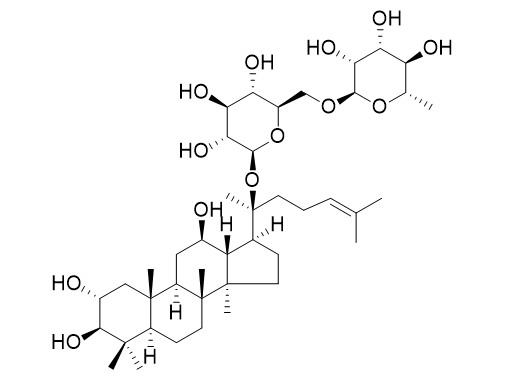Gynosaponin TN2
Gynosaponin TN-2 has anti-Parkinsonian activity.
Gynosaponin TN-2 exerts protective effects on L-DOPA (100 and 200 μM)-induced apoptotic cell death by modulating extracellular signal-regulated protein kinases 1 and 2 activation in pheochromocytoma 12 cells.
Inquire / Order:
manager@chemfaces.com
Technical Inquiries:
service@chemfaces.com
Tel:
+86-27-84237783
Fax:
+86-27-84254680
Address:
1 Building, No. 83, CheCheng Rd., Wuhan Economic and Technological Development Zone, Wuhan, Hubei 430056, PRC
Providing storage is as stated on the product vial and the vial is kept tightly sealed, the product can be stored for up to
24 months(2-8C).
Wherever possible, you should prepare and use solutions on the same day. However, if you need to make up stock solutions in advance, we recommend that you store the solution as aliquots in tightly sealed vials at -20C. Generally, these will be useable for up to two weeks. Before use, and prior to opening the vial we recommend that you allow your product to equilibrate to room temperature for at least 1 hour.
Need more advice on solubility, usage and handling? Please email to: service@chemfaces.com
The packaging of the product may have turned upside down during transportation, resulting in the natural compounds adhering to the neck or cap of the vial. take the vial out of its packaging and gently shake to let the compounds fall to the bottom of the vial. for liquid products, centrifuge at 200-500 RPM to gather the liquid at the bottom of the vial. try to avoid loss or contamination during handling.
Tropical J. of Pha. Research2017, 16(3):543-552
Cardiovasc Toxicol.2019, 19(4):297-305
Korean J. of Food Sci. and Tech2016, 172-177
Heliyon.2023, e12778.
Molecules. 2013, 18(7):7376-88
J Microbiol Biotechnol.2024, 35:e2408022.
Phytochem Anal.2024, 35(3):483-492.
J Nat Med.2021, doi: 10.1007.
Industrial Crops and Products2019, 140:111612
J Agric Food Chem.2024, 72(45):25219-25228.
Related and Featured Products
Neuroreport, 2018 Jan 3;29(1):1-5
Effects of gynosaponin TN-2 on L-DOPA-induced cytotoxicity in PC12 cells[Pubmed:
29120941]
Gynosaponins have pharmacological effects on 3,4-L-dihydroxyphenylalanine (L-DOPA)-related or dopamine-related neurological diseases; however, the neuroprotective functions of single compound of gynosaponins remain undefined. This study investigated the cytotoxic effects of gynosaponin TN-2 on L-DOPA in pheochromocytoma 12 cells. Gynosaponin TN-2, at 0.5-3 μM, did not exhibit cytotoxicity and protected against L-DOPA (100 and 200 μM)-induced cell death. Gynosaponin TN-2 (0.5 and 1.0 μM) inhibited the L-DOPA (100 and 200 μM)-induced sustained extracellular signal-regulated protein kinases 1 and 2 phosphorylation. Gynosaponin TN-2 at 0.5 and 1.0 μM also reduced L-DOPA (100 and 200 μM)-induced JNK1/2 phosphorylation and cleaved caspase-3 expression. These results suggested that gynosaponin TN-2 exerts protective effects on L-DOPA (100 and 200 μM)-induced apoptotic cell death by modulating extracellular signal-regulated protein kinases 1 and 2 activation in pheochromocytoma 12 cells.
Molecules, 2010 Apr 16;15(4):2814-24
Neuroprotective effects of herbal ethanol extracts from Gynostemma pentaphyllum in the 6-hydroxydopamine-lesioned rat model of Parkinson's disease[Pubmed:
20428081]
6-Hydroxydopamine administration for 28 days (8 microg/2 microL) reduced the number of tyrosine hydroxylase (TH)-immunopositive neurons to 40.2% in the substantia nigra compared to the intact contralateral side. Dopamine, 3,4-dihydroxyphenylacetic acid, homovanillic acid and norepinephrine levels were reduced to 19.1%, 52.3%, 47.1% and 67.4% in the striatum of 6-hydroxydopamine-lesioned rats compared to the control group, respectively. However, an oral administration of herbal ethanol extracts from Gynostemma pentaphyllum (GP-EX) (10 mg/kg and 30 mg/kg) starting on day 3 post-lesion for 28 days markedly ameliorated the reduction of TH-immunopositive neurons induced by 6-hydroxydopamine-lesioned rat brain from 40.2% to 67.4% and 75.8% in the substantia nigra. GP-EX administration (10 and 30 mg/kg) also recovered the levels of dopamine, 3,4-dihydroxyphenylacetic acid, homovanillic acid and norepinephrine in post-lesion striatum to 64.1% and 65.0%, 77.9% and 89.7%, 82.6% and 90.2%, and 88.1% and 89.2% of the control group. GP-EX at the given doses did not produce any sign of toxicity such as weight loss, diarrhea and vomiting in rats during the 28 day treatment period and four gypenoside derivatives, gynosaponin TN-1, gynosaponin TN-2, gypenoside XLV and gypenoside LXXIV were identified from GP-EX. These results suggest that GP-EX might be helpful in the prevention of Parkinson's disease.



